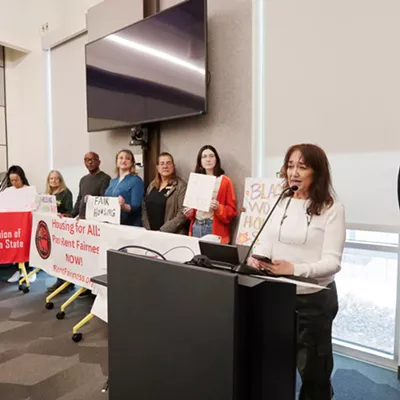Recent history is riddled with examples of criminals, celebrities, and politicians being tried in the court of public opinion. One need only look to yesterday's headlines to find examples of the media making or breaking someone's future by the spin they put on a story. Stories of scandal, from O.J. Simpson to Bill Clinton to the more recent speculation concerning Gary Condit are commonplace in today's media. But this phenomenon is not new. Back in the 1920s, the public loved a good story of sex and violence -- especially if it was true -- as much as we do today. And that is just what the Broadway musical Chicago, coming to the Opera House starting September 6, provides.
The musical, which first played on Broadway in the mid-1970s, was based on a play written in 1926 by journalist Maurine Dallas Watkins. Although Watkins tried to hide the play's ripped-from-the-headlines origins, the story is based on events Watkins covered as a journalist during that time. In the story, Roxie Hart is a flapper who kills her lover and then hires a big shot lawyer to spin the story in the media, transforming her from cheating murderess to beloved victim and media darling. Performer Heather Parcells, who plays the role of Velma, another notorious murderess in Chicago, says modern audiences are ripe for a play about the dark underbelly of the media's role in public opinion.
"The public yearns for the disgusting, the horrific and the traumatic," says Parcells. "It used to be sex, and now it's murder and success. You can't hide it anymore... because of technology, the stream of news and intelligence became so prevalent that we know exactly what's going on."
When the show first opened in 1975, the response was not nearly as positive as has been the case in this revival. Parcells believes the era was too steeped in post-Vietnam pain and early-disco optimism to embrace the dark themes of Chicago's story.
"I think in 1975 it was out-shadowed by A Chorus Line," says Parcells. "It was a happy-go-lucky musical about real people. Chicago seemed a little beyond belief, and people covered that stuff up a lot."
When the revival began in 1996, the public was primed and ready for the issues that 1975 audiences had avoided. The O.J. Simpson trial was fresh, Bill Clinton was in the White House and the public had cynicism to spare. "[Chicago] was exactly like what's going on outside their doors," Parcells says.
Since then the show has won six Tony Awards, five Drama Desk awards and a large assortment of other accolades, including a 1998 Grammy for Best Musical Show Album.
The show was created by Broadway legends John Kander and Fred Ebb (who were responsible for the shows Cabaret and Kiss of the Spider Woman, among others) with the help of Bob Fosse, who also choreographed and directed the original production. The revival is slightly streamlined in terms of sets, costumes and choreography, but it is a tribute to the creators that the show didn't need much tweaking to appeal to modern audiences.
"Fosse, Kander and Ebb don't do anything if it doesn't have a lot of weight," explains Parcells. "It's an immaculately written script."
She adds that the alterations made by director Walter Bobbie and choreographer Ann Reinking polished an already tight show and added a focus on the performers. The scantily dressed players and the band are all on a sparse stage, simply lighted.
"They did that on purpose; all you see is the playing area," says Parcells. "They didn't want any helicopters landing or chandeliers falling. They wanted the show, and that's it."
She explains that audiences have to suspend disbelief a little as the vaudevillian feel of the show plays itself out. Ensemble members might get shot in one scene, only to pop up in the next scene in another role. Characters often address the audience directly, involving them in their schemes.
"There is a lot of the 'fourth wall' being broken down," says Parcells. "It's a fun, funny show. It's in-your-face." But even with all these apparent antics, Parcells emphasizes that the show is not a romp. "This show, because of its content, is not really tongue-in-cheek. It's very important. It's definitely PG-13."
Her character, Velma, does her share to contribute to that PG-13 rating. Roxie Hart meets Velma in prison, where Velma is the criminal-du-jour and the sweetheart of the press, in spite of the fact that she killed her sister and her husband when she found them in bed together.
"Velma's the queen; she's the number-one person in the papers," explains Parcells. "Everyone pretty much kisses my feet at the jail." But all this changes when Roxie takes Velma's lead, woos the media and usurps her place in the limelight.
"When Roxie comes, she basically wants to know how to get where Velma is at. The media buys it completely," says Parcells. "Velma just gets cut down and cut down and cut down, then someone else comes along and knocks down Roxie."
This, explains Parcells, is one of the main messages of the show, that the media has the role of both manipulator and manipulated.
"It makes us focus on what it wants us to focus on," Parcells says.
Parcells, a self-described goody-two-shoes, admits that it is really fun to play someone who likes to scheme. "I love it. You can be evil and you can be mean and no repercussions!" she exclaims.
And in a play of unscrupulous characters playing the riches-to-rags underdog has its benefits. In spite of the fact that her character is complicit in all of this back-stabbing and spin-doctoring, Velma comes out looking like the lesser of two evils by the time Roxie has had her day in court.
"Velma's a tough, tough character. She's a survivor," Parcells asserts. "I think what people identify with is that she never gives up. Most people would want to scratch Roxie's eyes out, but each time Velma says, 'Now what do I have to do?' She's really the sympathetic character if I've done my job correctly."
The fact that a double murderess comes out as the most likable character tells you something about the warped world view the play presents. But unfortunately, that world view sounds uncomfortably familiar to the things we see in TV, films and the news every day. "These women and men on stage are beautiful, and scantily dressed, and you think, 'Wow, they look so good'. And yet they're talking about the most horrible act, killing someone."
This juxtaposition of beauty and horror is a far cry from the musical-theater topics that people have come to expect, but Parcells encourages audiences to explore the world of Chicago for clues about our own lives. "I think they should go with an open mind, and then let it sink in for a day. It's trying to show a message that the media and the press are trying to get us to believe what they want us to believe... It's an eye-opener in how people use each other."
Chicago plays at the Opera House on Thursday, Sept. 6, at 7:30 pm; Friday, Sept. 7, at 8 pm; Saturday, Sept. 8, at 2 and 8 pm; and Sunday, Sept. 9, at 2 and 8 pm.
Tickets: $20-$44. Call: 325-SEAT.
















